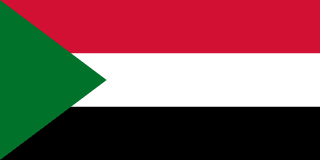Sudan - Geography

Here, let us take a look at the Geography of Sudan. The Nile is Sudan's primary water source; its major tributaries, the White Nile and the Blue Nile, meet at Khartoum to form the River Nile, which flows northward through Egypt to the Mediterranean Sea. Mother's mean age at first birth is (), whereas, the Maternal mortality ratio is 270 deaths/100,000 live births (2020 est.)
Geographical data of Sudan
| Location | north-eastern Africa, bordering the Red Sea, between Egypt and Eritrea |
|---|---|
| Geographic coordinates | 15 00 N, 30 00 E |
| Map references | Africa |
| Tarrain | generally flat, featureless plain; desert dominates the north |
| Natural Resources | petroleum; small reserves of iron ore, copper, chromium ore, zinc, tungsten, mica, silver, gold; hydropower |
| Natural Hazards | dust storms and periodic persistent droughts |
| Irrigated Land | 15,504 sq km (2019) |
| Major rivers (by length in km) | An Nīl (Nile) (shared with Rwanda [s], Tanzania, Uganda, South Sudan, and Egypt [m]) - 6,650 km; Blue Nile river mouth (shared with Ethiopia [s]) - 1,600 km |
| Major aquifers | Nubian Aquifer System, Sudd Basin (Umm Ruwaba Aquifer) |
| Land Boundaries | 6,819 km |
| Border Countries | Central African Republic 174 km; Chad 1,403 km; Egypt 1,276 km; Eritrea 682 km; Ethiopia 744 km; Libya 382 km; South Sudan 2,158 km |
| Coastline | 853 km |
| Climate | hot and dry; arid desert; rainy season varies by region (April to November) |
| Area | |
| Total Area | |
| Land Area | 1,731,671 sq km |
| Water Area | 129,813 sq km |
| comparative Area | slightly less than one-fifth the size of the US |
| Maritime Claims | |
| Territorial sea | 12 nm |
| Contiguous zone | 18 nm |
| Continental shelf | 200-m depth or to the depth of exploitation |
| Elevations | |
| Highest point | Jabal Marrah 3,042 m |
| Lowest point | Red Sea 0 m |
| Mean elevation | 568 m |
| Land Use | |
| Agricultural land | 60.3% (2022 est.) |
| Agricultural land: arable land | arable land: 11.2% (2022 est.) |
| Agricultural land: permanent crops | permanent crops: 0.1% (2022 est.) |
| Agricultural land: permanent pasture | permanent pasture: 49% (2022 est.) |
| Forest | 9.6% (2022 est.) |
| Other | 30% (2022 est.) |
Population Distribution
With the exception of a ribbon of settlement that corresponds to the banks of the Nile, northern Sudan, which extends into the dry Sahara, is sparsely populated; more abundant vegetation and broader access to water increases population distribution in the south extending habitable range along nearly the entire border with South Sudan; sizeable areas of population are found around Khartoum, southeast between the Blue and White Nile Rivers, and throughout South Darfur as shown on this population distribution map
People and Society
In Sudan, the different Ethnic groups are such that we have: Sudanese Arab (approximately 70%), Fur, Beja, Nuba, Ingessana, Uduk, Fallata, Masalit, Dajo, Gimir, Tunjur, Berti; there are over 500 ethnic groups
| Population | |
|---|---|
| Pop growth rate | 2.55% (2024 est.) |
| Birth rate | 33.1 births/1,000 population (2024 est.) |
| Death rate | 6.1 deaths/1,000 population (2024 est.) |
| Health expenditure | 2.8% of GDP (2021) |
| Physicians Density | |
| Hospital bed Density | 0.7 beds/1,000 population (2017) |
| Total fertility rate | 4.47 children born/woman (2024 est.) |
| Gross reproduction rate | 2.18 (2024 est.) |
| Contraceptive prevalence rate | 12.2% (2014) |
| Est married women (ages 15-49) | 61.4% (2023 est.) |
| Literacy | age 15 and over can read and write |
| Education expenditures | NA |
| Net Migration rate | -1.6 migrant(s)/1,000 population (2024 est.) |
| Nationality | Sudanese | Sudanese (singular and plural) |
| Languages | |
| Religions | Sunni Muslim, small Christian minority |
| Age Structure | |
| 0-14 years | 40.1% (male 10,278,453/female 9,949,343) |
| 15-64 years | 56.7% (male 14,211,514/female 14,390,486) |
| 65 years and over | 3.2% (2024 est.) (male 845,125/female 792,357) |
| Dependency Ratios | |
| Total dependency ratio | 76.9 |
| Youth dependency ratio | 74 |
| Elderly dependency ratio | 6.2 |
| Potential support ratio | 16.2 (2021 est.) |
| Median Age | |
| Total | 19.3 years (2024 est.) |
| Male | 19 years |
| Female | 19.6 years |
| Urbanization | |
| Urban population | 36.3% of total population (2023) |
| Rate of urbanization | 3.43% annual rate of change (2020-25 est.) |
| Major urban areas (Pop) | 6.344 million KHARTOUM (capital), 1.057 million Nyala (2023). |
| Sex Ratio | |
| At birth | 1.05 male(s)/female |
| 0-14 years | 1.03 male(s)/female |
| 15-64 years | 0.99 male(s)/female |
| 65 years and over | 1.07 male(s)/female |
| Total population | 1.01 male(s)/female (2024 est.) |
| Infant Motality | |
| Total | 40.6 deaths/1,000 live births (2024 est.) |
| Male | 46 deaths/1,000 live births |
| Female | 34.8 deaths/1,000 live births |
| Life Expectancy at birth | |
| Total population | 67.8 years (2024 est.) |
| Male | 65.5 years |
| Female | 70.2 years |
| Drinking Water Sources | |
| Improved: urban | urban: 99% of population |
| Improved: rural | rural: 80.7% of population |
| Improved: total | total: 87.1% of population |
| Unimproved: urban | urban: 1% of population |
| Unimproved: rural | rural: 19.3% of population |
| Unimproved: total | total: 12.9% of population (2020 est.) |
| Sanitation facility acess | |
| Improved: urban | urban: 72.1% of population |
| Improved: rural | rural: 30.6% of population |
| Improved: total | total: 45.3% of population |
| Unimproved: urban | urban: 27.9% of population |
| Unimproved: rural | rural: 69.4% of population |
| Unimproved: total | total: 54.7% of population (2020 est.) |
| Alcohol consumption per capita | |
| Total | 1.93 liters of pure alcohol (2019 est.) |
| Beer | 0 liters of pure alcohol (2019 est.) |
| Wine | 0 liters of pure alcohol (2019 est.) |
| Spirits | 0.29 liters of pure alcohol (2019 est.) |
| Other alcohols | 1.63 liters of pure alcohol (2019 est.) |
Demographic profile
All Important Facts about Sudan
Want to know more about Sudan? Check all different factbooks for Sudan below.









